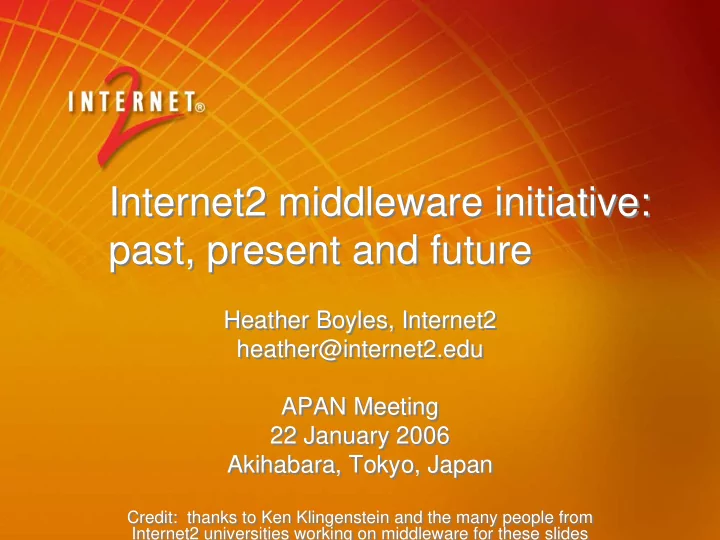

Internet2 middleware initiative: Internet2 middleware initiative: past, present and future past, present and future Heather Boyles, Internet2 Heather Boyles, Internet2 heather@internet2.edu heather@internet2.edu APAN Meeting APAN Meeting 22 January 2006 22 January 2006 Akihabara, Tokyo, Japan Akihabara, Tokyo, Japan Credit: thanks to Ken Klingenstein and the many people from Credit: thanks to Ken Klingenstein and the many people from Internet2 universities working on middleware for these slides Internet2 universities working on middleware for these slides
Internet2 Middleware Initiative Internet2 Middleware Initiative (I2MI) (I2MI) • Work begun late 1998 • Ken Klingenstein (U. Colorado) hired to lead • April 1999 • Recognized network-enabled collaboration between individuals, institutions needed more than just network infrastructure • NSF Middleware Initiative (NMI) • Internet2 as well as several others received some funding: enterprise + grid communities • Begun late 2001
Internet2 and middleware Internet2 and middleware • Internet2 is university-driven, membership- organization • Facilitate inter-institutional collaboration • Utilizing advanced network environment • Focus on the enterprise • Organizations that, as part of your belonging, help you manage your information and access in an electronic world – faculty, researcher, administrator, student on campus • Federated • 210 universities will never buy the same software
Why enterprises are important Why enterprises are important • Primary context for the Grid user • Logical – application contexts, auth n/z • Physical – firewalls, diagnostics • Policy - including auditability • Key use cases are enterprise centric • As potential deployers of enterprise Grids • A large part of the users collaborations are based on enterprise tools – vc, calendaring, web access, listprocs, wikis, webdavs, etc…
Scope of work Scope of work •Core middleware infrastructure • directories, authentication, authorization, etc. • in service to academic, administrative and research missions •Virtual organization support • basic collaboration tools • platforms such as GridShib •Deliverables • open source software (Shib, Signet, Grouper, etc.) • community standards (eduPerson, eduOrg) • best practices • dissemination and sharing • services (InCommon, USHER)
Internet2 core middleware Internet2 core middleware projects/results projects/results • eduPerson, eduOrg attribute standards • Shibboleth • An architecture and a software tool being adopted by several national, federated authentication and authorization infrastructures • InCommon • A national federation for US higher education based on Shibboleth • Authorization: Signet, Grouper tools • Signet – manages privileges (what can you do?) • Grouper – manages groups (who’s in it?)
Internet2 federation effort Internet2 federation effort • InCommon federation: • National authentication and authorization infrastructure • US universities (Internet2 members) join the federation, agree to trust each others’ own campus authentication mechanisms • Federating software – Shibboleth 1.2 and above • Federation data schema - eduPerson200210 or later and eduOrg200210 or later • Federated approach to security and privacy, with policies posted by members in common formats • Became fully operational 9/04 • http://www.incommonfederation.org
InCommon Users InCommon Users • Institutional users acquiring content from popular providers (Napster, etc.) and academic providers (Elsevier, JSTOR, EBSCO, Pro-Quest, etc.) • Institutions working with outsourced service providers, e.g. grading services, scheduling systems, software sales • Inter-institutional collaborations, including shared courses and students, research computing sharing, etc. • (Shared network security monitoring, federal research trust peering, interactions between students and federal applications, wireless network access, peering with international activities, etc.)
Why should APAN member networks be Why should APAN member networks be interested in middleware (AAIs?) interested in middleware (AAIs?) • In some places NRENS provide the AAI • In many instances, NRENs will need to use the AAI • For network bandwidth control • E.g. access to a ‘lightpath’ type service • For network diagnostics and management • E.g. access to network measurement and monitoring data/equipment • Faciliate campuses’ network access control • E.g. visiting faculty in “roaming” projects • NRENs are in the business of ultimately supporting the end-user - researchers, faculty students engaged inter-institutional e-Science, accessing digital libraries and other resources
Virtual Organizations Virtual Organizations • Geographically distributed, enterprise distributed community that shares real resources as an organization • computational resources, scientific instruments, bandwidth, shared data and content, economic data, museum materials, cultural and artistic works • Examples include team science (NEESGrid, HEP, BIRN, NEON), digital content managers (library cataloguers, curators, etc), a statebased life-long learning consortia, a group of researchers coordinating a launch vehicle payload, etc. • Want to leverage enterprise middleware and external trust fabrics, as well as support centers • Often the need to have some accounting and regulatory compliance
What’s next for Internet2 What’s next for Internet2 middleware middleware • Leverage middleware in network security work • using network authentication and authorization to help improve the security environment • E.g. role-based, policy-oriented personal firewalls • Further build-out of InCommon federation • More universities join • Consulting services • Moving developments into sustained maintenance mode • Shibboleth (a lot of international development now) • Signet, Grouper tools • Continued engagement with other national federations (NRENs developing and running federations) • International “interconnection” of federations • w/European colleagues, w/APAN countries
Recommend
More recommend